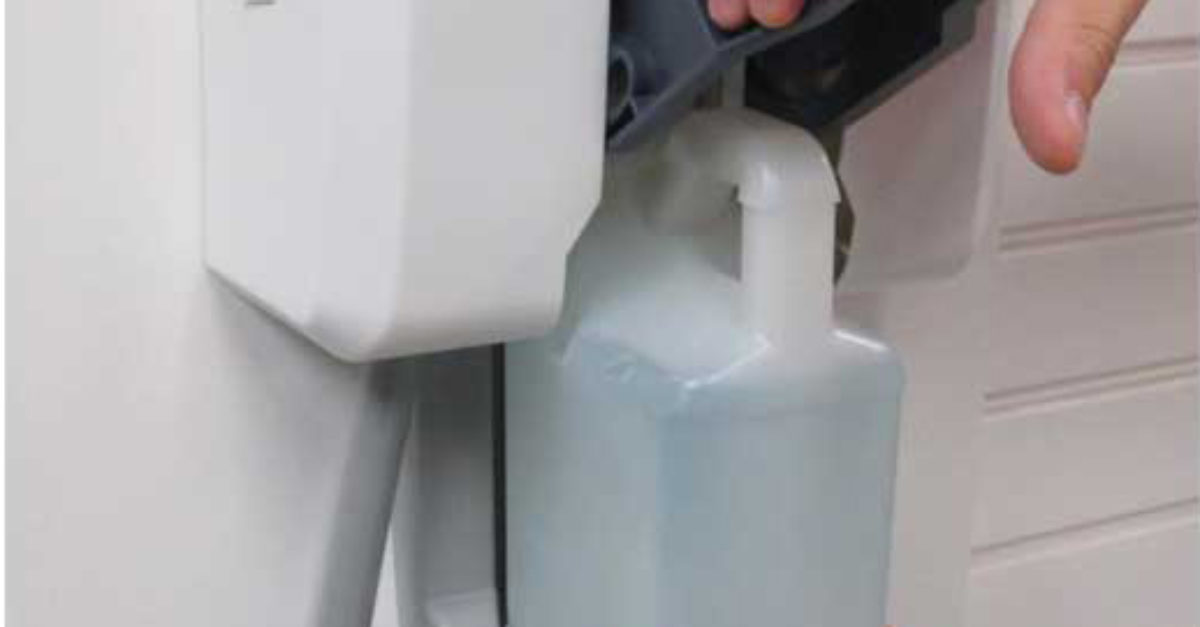Manually measuring cleaning chemicals is still a common practice, but it can quickly become a time-consuming, wasteful, and unsafe process. If employees incorrectly measure chemicals or water, the solution won’t perform as intended, resulting in inconsistent cleanliness levels and lost time caused by repeatedly cleaning the same surface. Additionally, if employees are exposed to harsh chemical fumes or spill chemicals onto the floor or their skin, an average day on the job suddenly becomes a hazardous situation.
Dispensing systems were created to prevent these situations. Chemical dispensers promise accuracy and reliability, saving facility managers time and money as well as providing peace of mind. Evolving technology makes it imperative for facility managers to understand the advancements in today’s dispensers to ensure the right system is used for everyday cleaning and sanitation needs.
The History of Dispensing Systems
The first chemical dilution system was a simple unit that screwed onto the end of a faucet. It was not incredibly accurate and was negatively affected by water pressure, but it was the beginning of a new way of cleaning. From accurate chemical measurements to a safer way of diluting and dispensing chemicals, dispensers have solved numerous problems.
Although dispensing systems have changed over time, they have always focused on ensuring accurate chemical dispensing, regulating chemical and water use, and preventing exposure to chemicals. As chemical dispensing systems become more in-tune with individual facility needs, the more effective and efficient cleaning becomes.
Today’s Dispensing Systems
Over the last 50 years, chemical dispensers have diversified thanks to advanced technology and innovative design. From compact sizes to versatile solutions, there’s a chemical dispensing system for any facility, regardless of its size or type.
Current dispenser capabilities include:
- Connectivity-Some of today’s systems utilize the Internet of Things (IoT) and feature wireless reporting capabilities, keeping facility managers connected to the system at all times. If an issue arises, such as being out of product, the system will immediately alert you, allowing for quick corrective action and minimal downtime.
- Reliability-Many dispensing systems are made with more durable, long-lasting materials that also are compatible with multiple chemicals. Dispensers are typically connected to water systems and thus require backflow protection. Most advanced systems are now built with eductors that meet the ASSE 1055 Performance Requirements, protecting against hazardous substances from entering the potable water system.
- Flexibility-Many systems can effectively dose several chemicals through one dispenser without the concerns of chemical carryover. This allows large facilities that utilize different types of chemical to use and rely on one dispensing system.
- Compact design-Small dispensing systems can be mounted to walls to optimize facility space. keeping systems at useful heights and off floors.
- Simplicity-Dispensing systems are now easier and quicker to install, allowing workers to start cleaning sooner. Many also include a user-friendly interface that makes it simple to use regardless of your experience level.
Better Dispensers, Better Benefits
As chemical dispensers adapt to modern-day needs, users experience more benefits. For example, dispensers that measure the right amount of chemical and water can help companies cut costs dramatically. However, some buildings don’t have a reliable source of water flow or pressure and not all dispensers will draw the correct amount. To ensure the right amount of water is used, it’s important to look for a dispenser that utilizes pressure-regulation technology.
Training new employees to use new and unfamiliar equipment can be difficult and time consuming. The more accurate and user-friendly the system is, the more productive a working environment becomes. Additionally, chemical dispensers provide a facility manager peace of mind, knowing that chemical will always be dispensed accurately and safely.
On top of these benefits, dispensing systems help facilities maintain a commitment to enhancing sustainability.Dispensers help reduce water, energy, and chemical waste through accurate measurements. Premixed and ready-to-use cleaning solutions are expensive to ship and can be harmful to the environment. Dispensing systems help reduce a facility’s carbon footprint with higher concentrated chemicals that are lighter in weight and easier to ship, limiting greenhouse gases with less fuel required for shipment. Additionally, chemicals used with dispensing systems create less packaging waste, decreasing the amount of waste in landfills.
Maintenance is key to maximize the benefits provided by a dispenser. Making the investment in an advanced dispenser will quickly pay off, but only if you maintain it, regularly checking and replacing metering tips, check valves, tubing, and filters.
A Cleaner, Brighter Future
No matter the size of the facility, dispensers often act as the central station for all cleaning needs. With today’s advancements, facilities can utilize affordable and reliable dispensing systems that meet industry requirements and provide unique insight into the cleaning process. With the right system, a facility can promote cleanliness and hygiene at every corner while also taking steps toward a more sustainable and cost-effective future.



